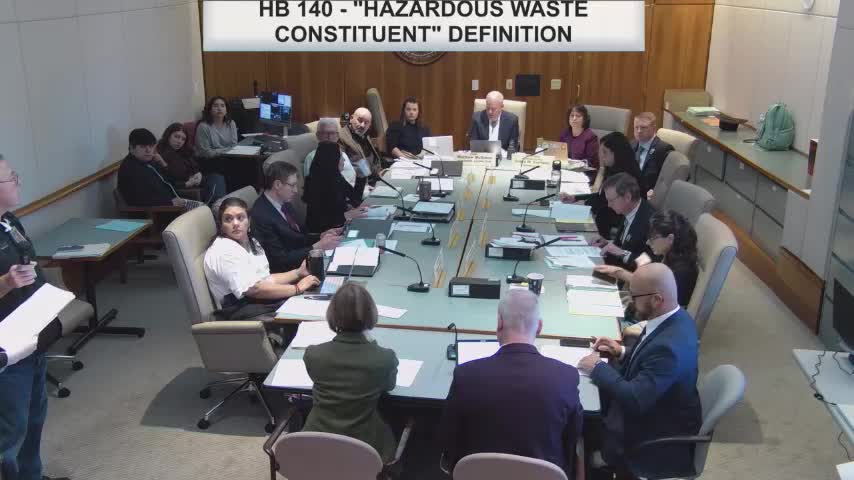New Mexico Legislators Debate HB 140 on PFAS Hazardous Waste Regulations
February 08, 2025 | Energy, Environment & Natural Resources, House of Representatives, Committees, Legislative, New Mexico
This article was created by AI summarizing key points discussed. AI makes mistakes, so for full details and context, please refer to the video of the full meeting. Please report any errors so we can fix them. Report an error »

In a pivotal meeting held by the New Mexico Legislature on February 8, 2025, discussions centered around a proposed bill aimed at expanding the state's authority to regulate hazardous waste, particularly concerning harmful substances like PFAS (per- and polyfluoroalkyl substances). The atmosphere in the room was charged with a mix of support and concern, as stakeholders from various sectors voiced their opinions on the implications of the legislation.
Ashley Wagner, vice president of government affairs for the New Mexico Oil and Gas Association, expressed cautious support for the bill but raised alarms about potential unintended consequences that could arise from the powers granted to the Environmental Improvement Board (EIB). Her sentiments were echoed by representatives from the Independent Petroleum Association of New Mexico and the Permian Basin Petroleum Association, who shared similar worries about loopholes that might affect the oil and gas industry.
On the other side of the debate, advocates for environmental reform passionately supported the bill. Marielle Nassy from New Energy Economy highlighted the critical need for local regulation of hazardous materials, citing alarming statistics about PFAS contamination in wildlife. Melissa Bernard from the Sierra Club emphasized the importance of empowering the EIB to classify hazardous constituents that the federal government has yet to regulate, arguing that this could significantly benefit public health and the environment.
The meeting also featured voices from the dairy industry, with Beverly Itzinga of the Dairy Producers of New Mexico expressing concerns about the potential liability for producers stemming from the bill. She acknowledged the efforts of Secretary Kenny in addressing PFAS issues but remained apprehensive about the implications for her industry.
As the discussions unfolded, Representative Chandler, a key sponsor of the bill, reassured the committee that the proposed changes would enhance New Mexico's ability to manage hazardous waste without being hindered by federal regulations. He pointed out that the state has previously taken steps to set stricter air quality standards and expressed hope for a future where all stakeholders could unite in support of effective legislation.
The meeting concluded with a sense of urgency surrounding the need for robust environmental protections, particularly in light of the ongoing challenges posed by PFAS and other hazardous materials. As New Mexico navigates the complexities of environmental regulation, the outcome of this bill could have far-reaching implications for public health, industry practices, and the state's ecological future.
Ashley Wagner, vice president of government affairs for the New Mexico Oil and Gas Association, expressed cautious support for the bill but raised alarms about potential unintended consequences that could arise from the powers granted to the Environmental Improvement Board (EIB). Her sentiments were echoed by representatives from the Independent Petroleum Association of New Mexico and the Permian Basin Petroleum Association, who shared similar worries about loopholes that might affect the oil and gas industry.
On the other side of the debate, advocates for environmental reform passionately supported the bill. Marielle Nassy from New Energy Economy highlighted the critical need for local regulation of hazardous materials, citing alarming statistics about PFAS contamination in wildlife. Melissa Bernard from the Sierra Club emphasized the importance of empowering the EIB to classify hazardous constituents that the federal government has yet to regulate, arguing that this could significantly benefit public health and the environment.
The meeting also featured voices from the dairy industry, with Beverly Itzinga of the Dairy Producers of New Mexico expressing concerns about the potential liability for producers stemming from the bill. She acknowledged the efforts of Secretary Kenny in addressing PFAS issues but remained apprehensive about the implications for her industry.
As the discussions unfolded, Representative Chandler, a key sponsor of the bill, reassured the committee that the proposed changes would enhance New Mexico's ability to manage hazardous waste without being hindered by federal regulations. He pointed out that the state has previously taken steps to set stricter air quality standards and expressed hope for a future where all stakeholders could unite in support of effective legislation.
The meeting concluded with a sense of urgency surrounding the need for robust environmental protections, particularly in light of the ongoing challenges posed by PFAS and other hazardous materials. As New Mexico navigates the complexities of environmental regulation, the outcome of this bill could have far-reaching implications for public health, industry practices, and the state's ecological future.
View full meeting
This article is based on a recent meeting—watch the full video and explore the complete transcript for deeper insights into the discussion.
View full meeting
